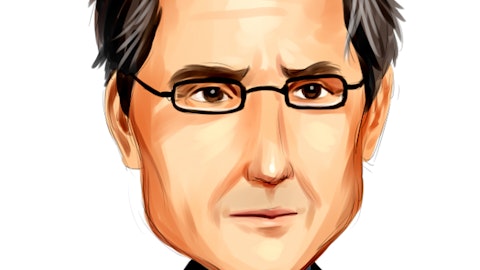And then within Mississippi, the increase that you saw there was driven by our mortgage company. We had some — we continued like everybody does, I think to see some increase in non-accruals coming out of our mortgage book, which is — so that’s — hopefully that gives you a little bit of color on that aspect of it. But we continue to monitor our portfolios very, very carefully. We’re looking at a lot of the credits on a quarterly basis. We’re looking at them. And specifically from a CRE perspective, we’re looking — we’re taking the pro forma and then we’re looking at today’s interest rates and determining what the debt service coverage looks like, what the debt yield looks like and evaluating them based upon today’s interest rate environment regardless of what the environment was at the time of underwriting.
So, we continue to assess it, and then as we need to adjust grades, we’re doing so in a very timely manner, well before we end up with a breach or a maturity.
Kevin Fitzsimmons: That’s helpful, Barry. While we’re on the subject of credit, to choose two kind of side questions, a number of your large Southeast bank peers were involved in a bankrupt syndicated credit. Can you remind us what kind of exposure you have to SNCs? And then equipment finance, I know you guys are just kind of in the infancy stage there of that business and it’s ramping up. But with the economy slowing in the mid higher rates, is there any concern about that book? I know, Duane, when we’ve talked about this before, you’d really emphasized how you’re really being careful and methodical in building that business. So I would assume you feel okay credit-wise, there.
Barry Harvey: Sure. And Kevin, I’ll start with the SNC question and will move to equipment finance. For our shared national credits, our percent of the total book is going to be — for outstanding, is going to be 8.6%. And I think there is a few things to comment beyond that is, we don’t have any concentrations from an industry standpoint, based upon the regulatory definition of concentrations. I would also like to mention kind of how we — while we kind of monitor SNCs within Trustmark, the credit quality for shared national credits given what they are is going to be near and oftentimes investment grade, so high-quality companies. And as a general statement, I mean, obviously with high-quality companies, you typically have less collateral as a general rule, because of the quality of the earnings, the strength of the earnings, the size of the earnings, the predictability of the earnings, all those things leads you to a credit process that the credit criteria and structure reflects the strength of the borrower that you’re lending to.
We typically are careful with taking a modest hold as we approach shared national credits. The credit itself was extremely strong, but they are — we’re always going to be buying into these credits, we don’t lead any shared national credits. So, as we buy into them, they’re take or leave, so really the only way to protect yourself from our perspective is to be modest with the size of the opportunity we pursue and put on our books. We’ve also established limits as it relates to shared national credits or a concentration limit, if you would. We’ve had that in place for many, many years. We displayed that to our Enterprise Risk Committee of the Board, who looks at everything credit from a Board perspective. We share that with them on a quarterly basis.
And so, we do in fact, we are conscious of shared national credits, maybe for a different reason than you’re asking the question for, we just want — we know that it’s purchase business and has limited opportunity for future ancillary business. So, we’re focused on making sure that we’re doing as much direct business as we can and getting as much of a wallet share from a customer as possible. So, we’re focused on those credits to make sure that we’re not doing those in lieu of the direct business that we want to be doing every day. So shifting over to the equipment finance side, I mean, we’ve got extremely experienced talented team that — they understand clearly that we’re looking to be down the middle of fairway on all the deals we’re looking at.
The credit structure, the credit quality is first and foremost. The pricing is important to us, but it’s always secondary to the borrower. We understand in a new line of business, we don’t want to stumble, we don’t want to have problems. So that is our focus and will continue to be our focus for the foreseeable future. And I do — I can’t overemphasize the experience level, the knowledge of the people we have in that line of business, including the credit resources that we were able to obtain that had been in that line of business for many, many years with some really large institutions. So from that standpoint, I’m very comfortable as we evaluate credits, which we will later this morning for opportunities that we’re looking at a good solid credit risk, down the fairway in terms of deal quality and making sure that’s our focus, and price is secondary, but we do want to make sure we get a reasonable yield given the credit quality being presented.
Duane Dewey: One, just final note on the equipment finance, Kevin is, it’s mid to large ticket, so it is — we’re not focused on small ticket or small business type stuff, it’s really mid to large and most of the credit in that portfolio is close to what Barry described from a SNC perspective, very top-line credit quality. So yeah, we feel pretty good about where we are at this point in that business.
Kevin Fitzsimmons: Okay, great. And I’m going to sneak one last one in here, Duane. I just want to point out not to be just that — your comment about liking the insurance business. I recall Cadence CEO saying that same thing on last quarter’s call. But putting that aside, like say there is no transaction there, would you look at doing on its own a securities restructuring transaction just to accelerate some of that redeployment or reinvestment on the securities portfolio?
Duane Dewey: Yeah, I’ll start quickly and let Tom address the securities portfolio. But again, I mean, we’ve been in the business 25 years, can’t comment much on what Cadence thought process is. But staying abreast, staying aware of what’s going on and looking at what’s best for Trustmark’s shareholders moving forward, that’s what we’re focused on. And it’s been a great business for us and continue to monitor the situation, but at this point in time, that’s where we stand. So, I’ll let Tom address the securities portfolio.
Tom Owens: So, Kevin, this is Tom Owens. So, I would probably echo Duane’s comments in terms of being aware and monitoring what our competitors and what our peers are doing. Certainly, we’re aware of the restructuring, the investment portfolio restructuring activity that’s been going on. So, we’re aware of it. We look at it. We are not, at this point, seriously contemplating doing that, I guess is the way I would say it.
Kevin Fitzsimmons: Okay, that’s great. Thanks, guys. Appreciate it.



